Moira Butterfield's Blog, page 50
April 10, 2016
Inspiration any time and any where - Lynne Garner
As a writer and teacher I'm always looking for new ways to fuel my own writing and ways to inspire my students. So earlier this year I decided to discover what writing related apps were available. After some time researching apps for iPhones and Android I downloaded a dozen or so. After much 'playing' I whittled my favourites down to the following three apps.
Story Lines
 Screens from 'Story Lines' Designed by: Magostech
Screens from 'Story Lines' Designed by: Magostech
Free to download from the following:
Amazon click here
iTunes click here
I love using story cubes and regularly use them to exercise my 'writing muscle' and in class to help inspire my students. The physical cubes I use in class come in packs of nine giving you 54 images. However these nine dice have ten images each, therefore offering more combinations.
To use you simply shake your phone or tablet and the dice scatter. You can then drag them into some order and lock the image. The one small issue I've found is if you don't lock the screen sometimes the dice roll so you lose the image the dice landed on for that roll. I've only used the app as a 'guest' however if you sign up you can also use the 'write story' facility.
This is a great app to have on you when you're sitting in that waiting room or on the train and want to exercise your imagination. Also after using a few times in class it's a great one to introduce to your students.
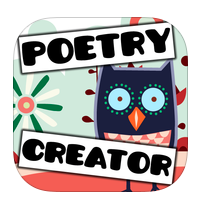
Poetry Creator
Developer: Tiny Mobile Inc.
Free to download with in app purchases
This app is fun, easy to use and really pushes the creative process. Think fridge magnet or rip it poetry. When you open the app you are supplied with a number of words on a 'board' which provides you with the starting point for your poem. These words you simply drag into place to create your poem. If you struggle there is a pull out 'drawer' (found on the right hand side of the screen) which contains additional words that you can pull into play. You can increase the number of words by going into the 'mix-tionary' and sliding the selectors.
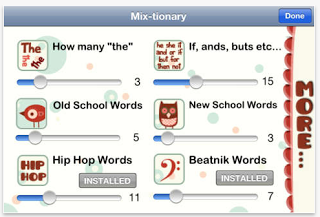 You can download additional dictionaries (shown as installed on the image on the left) from here or download eight dictionaries for a special price from the menu page.
You can download additional dictionaries (shown as installed on the image on the left) from here or download eight dictionaries for a special price from the menu page.
Once you've written your poem you can upload to Facebook to show off your skills, email to yourself or save to the photo album on your device. Do remember if you don't do any of these before you press the double arrow button (second icon from the right along the bottom of the screen) you lose your poem.
Unfortunately this app is only available for download onto iPhone and iPad - click here if you want to download which means I won't be able to use in class but it's definitely one I'll be adding to my handouts.
Acrostic Poems
Developer: International Reading Association
 Free to download from the following:
Free to download from the following:
To play online click here To download to your iPad click hereTo download to your Android device click here
Definition of an acrostic poem (just in case it's not one you've come across before): Is a type of poem where the first, last or other letters in a line spell out a word or phrase. The most common is where the first letters of each line spell out the word or phrase.
As with many of the apps I've downloaded over the last couple of months I did so because I wanted to use in my creative writing sessions. So far I've used this one in three sessions. Two were with year 4 and 5 kids whilst the third session was with a group of students who were 60 plus. All three sessions were (thankfully) a success.
The first screen asks you to enter your name and then the theme/word you wish to use as the basis for your acrostic poem. When you pick your theme you're limited to 14 characters which includes any spaces and it doesn't include a spell checker, so take care as you type. Your next step is to brainstorm ten words that link with your theme.
 Once you've completed this step simply start to create your poem using the words generated during your brainstorming session. When you've completed your poem, checked your spelling you can save it, share via email or print it off. If you forget to do any of these and click on 'new poem' you are told that the poem will be lost and you're given the chance to save your work.
Once you've completed this step simply start to create your poem using the words generated during your brainstorming session. When you've completed your poem, checked your spelling you can save it, share via email or print it off. If you forget to do any of these and click on 'new poem' you are told that the poem will be lost and you're given the chance to save your work.
Having seen students use this app in class it's another I'll be adding to my handouts when I update them next. It's also given me a few ideas for new stories which are now safely stored in OneNote.
I hope you've found these reviews helpful and if you've used any writing related apps you've enjoyed using please do share below.
Lynne
Now for a blatant plug - don't say I didn't warn you:
My latest short story collection Coyote Tales Retold is available on Amazon in ebook format. Also available Meet The Tricksters a collection of 18 short stories featuring Anansi the Trickster Spider, Brer Rabbit and Coyote is available as a paper back and an ebook.
I run the following online courses for Women On Writing:
How to write A children's book and get published
5 picture books in 5 weeks
How to write a hobby-based how to book
Story Lines
 Screens from 'Story Lines' Designed by: Magostech
Screens from 'Story Lines' Designed by: MagostechFree to download from the following:
Amazon click here
iTunes click here
I love using story cubes and regularly use them to exercise my 'writing muscle' and in class to help inspire my students. The physical cubes I use in class come in packs of nine giving you 54 images. However these nine dice have ten images each, therefore offering more combinations.
To use you simply shake your phone or tablet and the dice scatter. You can then drag them into some order and lock the image. The one small issue I've found is if you don't lock the screen sometimes the dice roll so you lose the image the dice landed on for that roll. I've only used the app as a 'guest' however if you sign up you can also use the 'write story' facility.
This is a great app to have on you when you're sitting in that waiting room or on the train and want to exercise your imagination. Also after using a few times in class it's a great one to introduce to your students.

Poetry Creator
Developer: Tiny Mobile Inc.
Free to download with in app purchases
This app is fun, easy to use and really pushes the creative process. Think fridge magnet or rip it poetry. When you open the app you are supplied with a number of words on a 'board' which provides you with the starting point for your poem. These words you simply drag into place to create your poem. If you struggle there is a pull out 'drawer' (found on the right hand side of the screen) which contains additional words that you can pull into play. You can increase the number of words by going into the 'mix-tionary' and sliding the selectors.
 You can download additional dictionaries (shown as installed on the image on the left) from here or download eight dictionaries for a special price from the menu page.
You can download additional dictionaries (shown as installed on the image on the left) from here or download eight dictionaries for a special price from the menu page.Once you've written your poem you can upload to Facebook to show off your skills, email to yourself or save to the photo album on your device. Do remember if you don't do any of these before you press the double arrow button (second icon from the right along the bottom of the screen) you lose your poem.
Unfortunately this app is only available for download onto iPhone and iPad - click here if you want to download which means I won't be able to use in class but it's definitely one I'll be adding to my handouts.
Acrostic Poems
Developer: International Reading Association
 Free to download from the following:
Free to download from the following:To play online click here To download to your iPad click hereTo download to your Android device click here
Definition of an acrostic poem (just in case it's not one you've come across before): Is a type of poem where the first, last or other letters in a line spell out a word or phrase. The most common is where the first letters of each line spell out the word or phrase.
As with many of the apps I've downloaded over the last couple of months I did so because I wanted to use in my creative writing sessions. So far I've used this one in three sessions. Two were with year 4 and 5 kids whilst the third session was with a group of students who were 60 plus. All three sessions were (thankfully) a success.
The first screen asks you to enter your name and then the theme/word you wish to use as the basis for your acrostic poem. When you pick your theme you're limited to 14 characters which includes any spaces and it doesn't include a spell checker, so take care as you type. Your next step is to brainstorm ten words that link with your theme.
 Once you've completed this step simply start to create your poem using the words generated during your brainstorming session. When you've completed your poem, checked your spelling you can save it, share via email or print it off. If you forget to do any of these and click on 'new poem' you are told that the poem will be lost and you're given the chance to save your work.
Once you've completed this step simply start to create your poem using the words generated during your brainstorming session. When you've completed your poem, checked your spelling you can save it, share via email or print it off. If you forget to do any of these and click on 'new poem' you are told that the poem will be lost and you're given the chance to save your work.Having seen students use this app in class it's another I'll be adding to my handouts when I update them next. It's also given me a few ideas for new stories which are now safely stored in OneNote.
I hope you've found these reviews helpful and if you've used any writing related apps you've enjoyed using please do share below.
Lynne
Now for a blatant plug - don't say I didn't warn you:
My latest short story collection Coyote Tales Retold is available on Amazon in ebook format. Also available Meet The Tricksters a collection of 18 short stories featuring Anansi the Trickster Spider, Brer Rabbit and Coyote is available as a paper back and an ebook.
I run the following online courses for Women On Writing:
How to write A children's book and get published
5 picture books in 5 weeks
How to write a hobby-based how to book
Published on April 10, 2016 23:00
April 4, 2016
Picture books that made me pause (for good, bad and surprising reasons) - Paeony Lewis
I read a lot of picture books and occasionally something will make me pause. This might be a good pause, a bad pause, or a surprised pause. It all depends on what has caught my attention. Here are a few of my picture-book ‘pauses’ (good, bad and surprising). Perhaps you wouldn’t have paused for some, though I bet many of you would pause at the third one. But first...
Pause 1: Last Stop on Market Street by Matt de la Pena, illus by Christian Robinson
I’ll begin with the book that gave me the idea for this blog post. Only published in 2015, Last Stop on Market Street has received an outstanding number of book awards in the USA, so I felt compelled to order a copy (I’m a bit of a pushover). When it arrived I opened the book and paused at the first sentence: CJ pushed through the church doors and skipped down the steps.
.
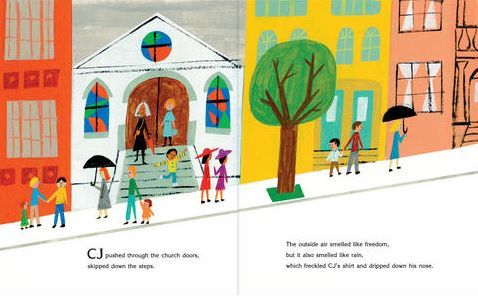 From Last Stop on Market Street by Matt de la Pena and Christian Robinson (G P Putnam's Sons, 2015)
From Last Stop on Market Street by Matt de la Pena and Christian Robinson (G P Putnam's Sons, 2015)
I wonder if some of you think it's weird that I paused? For me in the UK, it was the mention of the church doors in a mainstream picture book. Of course we can all interpret books to reflect our beliefs, but in this book it’s clear the grandmother and child have been to Sunday church.
After my surprised ‘pause’, I realised it could be a cultural difference between the UK and USA. In the UK, I don't think it's usual for contemporary picture books to overtly include Christianity unless the books are specifically religious. Also, UK publishers rely on overseas editions and I suspect that makes them cautious. So although the message in the delightful Last Stop on Market Street is one of finding beauty in less obvious places, it’s so specifically a story set in urban America, with the speech cadence of a specific community, that perhaps it’s a story that doesn’t travel well outside the USA?
Pause 2: Croc and Bird by Alexis Deacon
Cute animals are sooooo cute. We adore them in picture books. So it was a refreshing surprise to discover the baby bird in Croc and Bird was, well, how can I say this… Not cute. This book is about being true to yourself and the people who matter, and is one of my favourites (and sometimes I still pause and grin).
 From Croc and Bird by Alexis Deacon (Hutchinson 2012)
From Croc and Bird by Alexis Deacon (Hutchinson 2012)
Now we come to the third book. A bad ‘pause’ (in my opinion!).
Pause 3: The Lonely Doll by Dare Wright
When my daughter was young I spied this on the picture-book shelves of a mainstream bookshop. I thought the use of photography was interesting, so I bought it. I think I only read it once to my daughter. ‘Disturbing’ is the word I’d use. I know it was first produced in 1957 and that was a different time, but then it was reprinted in 1985, and again in 1998. The text on the page that made me pause reads:
"I may be a silly," Mr. Bear answered, "but I know when a naughty little girl needs a spanking." Little Bear couldn't watch. He was afraid his turn was next.
And yes, Little Bear gets a spanking too in the next image. Nuff said.
 From The Lonely Doll by Dare Wright
From The Lonely Doll by Dare Wright
Pause 4: The Three Robbers by Tomi Unigerer
This is another picture book that gave me a bad, shocked ‘pause’ when the robbers blew pepper dust at the frightened horses. However, when I finished the book I had a rethink. The robbers do terrible things, but is redemption possible? I’m not comfortable with the book, but I suspect it’s not meant to be ‘liked’; it’s meant to make adults and older children think about redemption. It was first published in German in 1963, then reissued in 2008 (Phaidon).
The text with the image below reads: To stop carriages, the robbers blew pepper dust in the horses' eyes.
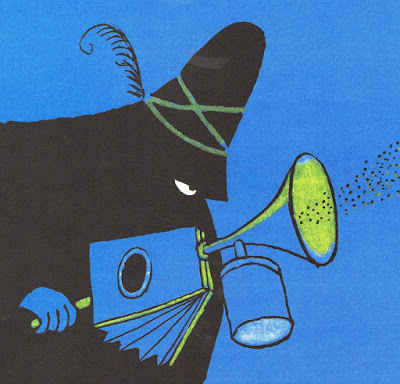 Image from The Three Robbers by Tomi Unigerer
Image from The Three Robbers by Tomi Unigerer
Pause 5: Tomorrow by Nadine Kaadan
 Cover of Tomorrow by Nadine Kaadan
Cover of Tomorrow by Nadine Kaadan
(Box of Tales Publishing House, 2012)Here’s another book that could get us all thinking and I ‘paused’ several times. It's Syrian and currently only in Arabic (though my copy included two separate sheets with the text translated into English). On the surface this picture book is about a family coping with living in a city that has become dangerous and scary. Parts of the story and illustrations are darker than the picture books we’re used to seeing in the UK, but even in the UK not all children live in safe neighbourhoods and most catch glimpses of the TV news.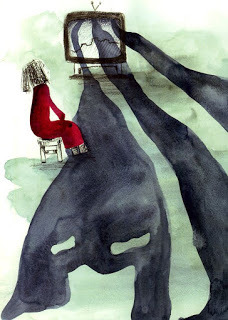 Image from Tomorrow by Nadine Kaadan
Image from Tomorrow by Nadine Kaadan
At first I questioned why the story didn't include the word 'war'. Nadine Kaadan (who has lived in the UK since 2012) explained that back in 2011, when she began the story, Syrians like herself didn’t believe the fighting around them was a ‘war’. They thought it would soon be over. Sadly not.
Now I’ve thought more about the story, I can see it has a wider appeal by not specifically mentioning war. The ambiguity works well. For example, it could also be seen as coping with a depressed parent, or coping with living in an unsafe environment, or simply coping with not being allowed outside to play. Don't worry, there is a positive, uplifting ending.
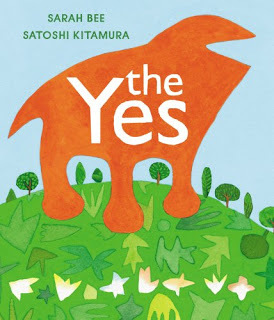
Pause 6: The Yes by Sarah Bee and Satoshi Kitamura
As the owner of cute picture books by Satoshi Kitamura (eg the Comic Adventures of Boots), I experienced a surprised ‘pause’ when I discovered his illustrations in The Yes (Andersen Press, 2015). For me it was a good surprise because the images are innovative for picture books. Some of the pictures are almost semi abstract, though always understandable and always interesting.
Pause 7: The Great Dog Bottom Swap by Peter Bentley and Mei Matsuoka
 From The Great Dog Bottom Swap by Peter Bentley and Mei MatsuokaAnother from Andersen Press (2010). I definitely paused when I came to this double-page spread. I was flabbergasted, bemused and then giggled. What more can I say?! Well I could tell you the text and then you might understand: So as they went in - every dog, pooch and pup -They took off their bottoms and hung them all up. Hundreds and hundreds of little pink 'o's All neatly arranged in methodical rows.
From The Great Dog Bottom Swap by Peter Bentley and Mei MatsuokaAnother from Andersen Press (2010). I definitely paused when I came to this double-page spread. I was flabbergasted, bemused and then giggled. What more can I say?! Well I could tell you the text and then you might understand: So as they went in - every dog, pooch and pup -They took off their bottoms and hung them all up. Hundreds and hundreds of little pink 'o's All neatly arranged in methodical rows.
Pause 8: Hector and Hummingbird by Nicholas John Frith
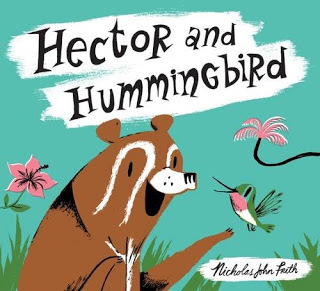
 When I’m in a bookshop I read a lot of picture books. Some I skim and some I read (and some I even buy - honestly!). So whilst in a bookshop I began to flick through Hector and Hummingbird (Alison Green Books, 2015) because I liked the colours and contemporary-retro illustrations, and then I paused. The snippets I'd read made me smile so much, I returned to the beginning and read it all through. It’s not often I come across such charming, witty fun (it’s about coping with an annoying, overly chatty friend). A delightful ‘pause’ and a gentle place to finish my list.
When I’m in a bookshop I read a lot of picture books. Some I skim and some I read (and some I even buy - honestly!). So whilst in a bookshop I began to flick through Hector and Hummingbird (Alison Green Books, 2015) because I liked the colours and contemporary-retro illustrations, and then I paused. The snippets I'd read made me smile so much, I returned to the beginning and read it all through. It’s not often I come across such charming, witty fun (it’s about coping with an annoying, overly chatty friend). A delightful ‘pause’ and a gentle place to finish my list.
I've had many more picture book 'pauses' but unfortunately I think this blog is getting a bit overlong. Perhaps you’ll let me know your good, bad and surprising ‘pauses’?
- Paeony Lewis
Pause 1: Last Stop on Market Street by Matt de la Pena, illus by Christian Robinson
I’ll begin with the book that gave me the idea for this blog post. Only published in 2015, Last Stop on Market Street has received an outstanding number of book awards in the USA, so I felt compelled to order a copy (I’m a bit of a pushover). When it arrived I opened the book and paused at the first sentence: CJ pushed through the church doors and skipped down the steps.
.
 From Last Stop on Market Street by Matt de la Pena and Christian Robinson (G P Putnam's Sons, 2015)
From Last Stop on Market Street by Matt de la Pena and Christian Robinson (G P Putnam's Sons, 2015)I wonder if some of you think it's weird that I paused? For me in the UK, it was the mention of the church doors in a mainstream picture book. Of course we can all interpret books to reflect our beliefs, but in this book it’s clear the grandmother and child have been to Sunday church.
After my surprised ‘pause’, I realised it could be a cultural difference between the UK and USA. In the UK, I don't think it's usual for contemporary picture books to overtly include Christianity unless the books are specifically religious. Also, UK publishers rely on overseas editions and I suspect that makes them cautious. So although the message in the delightful Last Stop on Market Street is one of finding beauty in less obvious places, it’s so specifically a story set in urban America, with the speech cadence of a specific community, that perhaps it’s a story that doesn’t travel well outside the USA?
Pause 2: Croc and Bird by Alexis Deacon
Cute animals are sooooo cute. We adore them in picture books. So it was a refreshing surprise to discover the baby bird in Croc and Bird was, well, how can I say this… Not cute. This book is about being true to yourself and the people who matter, and is one of my favourites (and sometimes I still pause and grin).
 From Croc and Bird by Alexis Deacon (Hutchinson 2012)
From Croc and Bird by Alexis Deacon (Hutchinson 2012)Now we come to the third book. A bad ‘pause’ (in my opinion!).
Pause 3: The Lonely Doll by Dare Wright
When my daughter was young I spied this on the picture-book shelves of a mainstream bookshop. I thought the use of photography was interesting, so I bought it. I think I only read it once to my daughter. ‘Disturbing’ is the word I’d use. I know it was first produced in 1957 and that was a different time, but then it was reprinted in 1985, and again in 1998. The text on the page that made me pause reads:
"I may be a silly," Mr. Bear answered, "but I know when a naughty little girl needs a spanking." Little Bear couldn't watch. He was afraid his turn was next.
And yes, Little Bear gets a spanking too in the next image. Nuff said.
 From The Lonely Doll by Dare Wright
From The Lonely Doll by Dare Wright Pause 4: The Three Robbers by Tomi Unigerer
This is another picture book that gave me a bad, shocked ‘pause’ when the robbers blew pepper dust at the frightened horses. However, when I finished the book I had a rethink. The robbers do terrible things, but is redemption possible? I’m not comfortable with the book, but I suspect it’s not meant to be ‘liked’; it’s meant to make adults and older children think about redemption. It was first published in German in 1963, then reissued in 2008 (Phaidon).
The text with the image below reads: To stop carriages, the robbers blew pepper dust in the horses' eyes.
 Image from The Three Robbers by Tomi Unigerer
Image from The Three Robbers by Tomi UnigererPause 5: Tomorrow by Nadine Kaadan
 Cover of Tomorrow by Nadine Kaadan
Cover of Tomorrow by Nadine Kaadan (Box of Tales Publishing House, 2012)Here’s another book that could get us all thinking and I ‘paused’ several times. It's Syrian and currently only in Arabic (though my copy included two separate sheets with the text translated into English). On the surface this picture book is about a family coping with living in a city that has become dangerous and scary. Parts of the story and illustrations are darker than the picture books we’re used to seeing in the UK, but even in the UK not all children live in safe neighbourhoods and most catch glimpses of the TV news.
 Image from Tomorrow by Nadine Kaadan
Image from Tomorrow by Nadine Kaadan
At first I questioned why the story didn't include the word 'war'. Nadine Kaadan (who has lived in the UK since 2012) explained that back in 2011, when she began the story, Syrians like herself didn’t believe the fighting around them was a ‘war’. They thought it would soon be over. Sadly not.
Now I’ve thought more about the story, I can see it has a wider appeal by not specifically mentioning war. The ambiguity works well. For example, it could also be seen as coping with a depressed parent, or coping with living in an unsafe environment, or simply coping with not being allowed outside to play. Don't worry, there is a positive, uplifting ending.

Pause 6: The Yes by Sarah Bee and Satoshi Kitamura
As the owner of cute picture books by Satoshi Kitamura (eg the Comic Adventures of Boots), I experienced a surprised ‘pause’ when I discovered his illustrations in The Yes (Andersen Press, 2015). For me it was a good surprise because the images are innovative for picture books. Some of the pictures are almost semi abstract, though always understandable and always interesting.
Pause 7: The Great Dog Bottom Swap by Peter Bentley and Mei Matsuoka
 From The Great Dog Bottom Swap by Peter Bentley and Mei MatsuokaAnother from Andersen Press (2010). I definitely paused when I came to this double-page spread. I was flabbergasted, bemused and then giggled. What more can I say?! Well I could tell you the text and then you might understand: So as they went in - every dog, pooch and pup -They took off their bottoms and hung them all up. Hundreds and hundreds of little pink 'o's All neatly arranged in methodical rows.
From The Great Dog Bottom Swap by Peter Bentley and Mei MatsuokaAnother from Andersen Press (2010). I definitely paused when I came to this double-page spread. I was flabbergasted, bemused and then giggled. What more can I say?! Well I could tell you the text and then you might understand: So as they went in - every dog, pooch and pup -They took off their bottoms and hung them all up. Hundreds and hundreds of little pink 'o's All neatly arranged in methodical rows.Pause 8: Hector and Hummingbird by Nicholas John Frith

 When I’m in a bookshop I read a lot of picture books. Some I skim and some I read (and some I even buy - honestly!). So whilst in a bookshop I began to flick through Hector and Hummingbird (Alison Green Books, 2015) because I liked the colours and contemporary-retro illustrations, and then I paused. The snippets I'd read made me smile so much, I returned to the beginning and read it all through. It’s not often I come across such charming, witty fun (it’s about coping with an annoying, overly chatty friend). A delightful ‘pause’ and a gentle place to finish my list.
When I’m in a bookshop I read a lot of picture books. Some I skim and some I read (and some I even buy - honestly!). So whilst in a bookshop I began to flick through Hector and Hummingbird (Alison Green Books, 2015) because I liked the colours and contemporary-retro illustrations, and then I paused. The snippets I'd read made me smile so much, I returned to the beginning and read it all through. It’s not often I come across such charming, witty fun (it’s about coping with an annoying, overly chatty friend). A delightful ‘pause’ and a gentle place to finish my list.I've had many more picture book 'pauses' but unfortunately I think this blog is getting a bit overlong. Perhaps you’ll let me know your good, bad and surprising ‘pauses’?
- Paeony Lewis
Published on April 04, 2016 00:00
March 28, 2016
THE PICTURE BOOK EVENT ANXIETY CHECK LIST
by Michelle Robinson
Event coming up? Worried you’ll forget to WORRY about something? Fret no more. This handy checklist of unnecessary anxieties is guaranteed to have you losing sleep for weeks.I will not find the venue.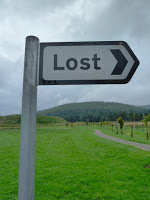 Not even on the map.I will find the venue is insalubrious.I will turn up on the wrong day/week/month/continent.My car will break down or else I will crash it. Probably into the venue. Or the children.The train will be cancelled. The train will break down. I will crash the train.I will be late. I will be flustered. Everything will go wrong.I will be early. I will still be flustered,. There will be no excuse for anything to go wrong, and yet absolutely everything will.I will have to cancel due to crippling anxiety and/or illness. I will let everyone down. I will damage my reputation and no on will ever ask me to do an event again. Fingers crossed.The promised essentials (powerpoint, flip chart, paper, pens, valium, etc.) will not materialise.I will leave my books at home.I will leave my memory stick at home with my slideshow on it.I will remember the memory stick, but will bring the wrong file, most likely something inappropriate or incriminating.The event organiser will be unable to conceal their disappointment in me.The children will boo and chant, “WE WANT THE GRUFFALO.”I will have to read ‘The Gruffalo.’No one will turn up.
Not even on the map.I will find the venue is insalubrious.I will turn up on the wrong day/week/month/continent.My car will break down or else I will crash it. Probably into the venue. Or the children.The train will be cancelled. The train will break down. I will crash the train.I will be late. I will be flustered. Everything will go wrong.I will be early. I will still be flustered,. There will be no excuse for anything to go wrong, and yet absolutely everything will.I will have to cancel due to crippling anxiety and/or illness. I will let everyone down. I will damage my reputation and no on will ever ask me to do an event again. Fingers crossed.The promised essentials (powerpoint, flip chart, paper, pens, valium, etc.) will not materialise.I will leave my books at home.I will leave my memory stick at home with my slideshow on it.I will remember the memory stick, but will bring the wrong file, most likely something inappropriate or incriminating.The event organiser will be unable to conceal their disappointment in me.The children will boo and chant, “WE WANT THE GRUFFALO.”I will have to read ‘The Gruffalo.’No one will turn up.
 Not even remotely likely.Everyone will turn up.Johnny Depp will turn up and I will not be able to think of the first thing to say to him.Nose bleed.Panic attack.Fainting.Sudden inexplicable onset of Tourette’s. Earthquake.Volcano.Tsunami.Alien invasion.Brain drain.Someone will look at me funny, putting me off my stride so badly I launch involuntarily into a musical number from Grease.The children will be Mensa protégés who correct me on my grammar.A child will ask a question that destroys or unhinges me.I will fall flat on my face. I will catch shingles from lingering pox on the venue carpet.These are pre-school children. I could even catch bubonic plague.The organiser will not have arranged book sales.
Not even remotely likely.Everyone will turn up.Johnny Depp will turn up and I will not be able to think of the first thing to say to him.Nose bleed.Panic attack.Fainting.Sudden inexplicable onset of Tourette’s. Earthquake.Volcano.Tsunami.Alien invasion.Brain drain.Someone will look at me funny, putting me off my stride so badly I launch involuntarily into a musical number from Grease.The children will be Mensa protégés who correct me on my grammar.A child will ask a question that destroys or unhinges me.I will fall flat on my face. I will catch shingles from lingering pox on the venue carpet.These are pre-school children. I could even catch bubonic plague.The organiser will not have arranged book sales.
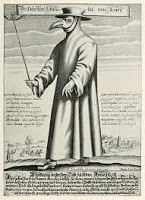 Not even possible, really.The organiser will expect me to bring along books and cash float. They will also expect me to do maths while talking and signing books for children with names like, "Eve, spelled Yvxwezfgh."I will not sell a single book and everyone will know I am a loser.No one will offer me a drink all day.Someone will offer me a drink but I will start choking on it, mid-story.I will choke to death in front of everybody.I will not be able to locate the loo.I will have an accident.Looking for the loo, I will enter the broom cupboard and have to style it out.…resulting in a request to read ‘Room on the Broom.’My family will resent me for spending time away from home.My children will forget what I look like.My husband will think I am away so much I must be having an affair.I will go all that way and - assuming #18 did not happen - there will not be anyone worth having an affair with.No one would want to have an affair with me anyway: I arrive a witless, charmless mess dressed as an impoverished bag lady.A local newspaper journalist will come and take a horrible photo, capturing my dishevelled bag lady look forever and making it the most prominent image result for me in Google.The photo will appear in the paper with the caption, ‘Not even Julia Donaldson’.
Not even possible, really.The organiser will expect me to bring along books and cash float. They will also expect me to do maths while talking and signing books for children with names like, "Eve, spelled Yvxwezfgh."I will not sell a single book and everyone will know I am a loser.No one will offer me a drink all day.Someone will offer me a drink but I will start choking on it, mid-story.I will choke to death in front of everybody.I will not be able to locate the loo.I will have an accident.Looking for the loo, I will enter the broom cupboard and have to style it out.…resulting in a request to read ‘Room on the Broom.’My family will resent me for spending time away from home.My children will forget what I look like.My husband will think I am away so much I must be having an affair.I will go all that way and - assuming #18 did not happen - there will not be anyone worth having an affair with.No one would want to have an affair with me anyway: I arrive a witless, charmless mess dressed as an impoverished bag lady.A local newspaper journalist will come and take a horrible photo, capturing my dishevelled bag lady look forever and making it the most prominent image result for me in Google.The photo will appear in the paper with the caption, ‘Not even Julia Donaldson’.
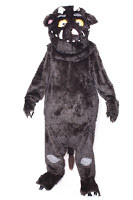 Not even my book.The photo will not appear, being deemed less newsworthy than a sponsored shoeshine. My publishers will not even notice that I am hauling my arse all over the country to promote our book.My publishers will notice, but will be too busy celebrating the umpteenth reprint of ‘The Gruffalo' to care.My publishers will see the terrible national newspaper write-up with the unfortunate photo of me, book aloft, smiling, beside the burning venue and sobbing children.There will not be cake.There will be cake, but I will choke on it.Repeat anxiety #39.They will ring to cancel when I am five minutes away because, “We thought you had written ‘The Gruffalo'.”Julia Donaldson will turn up, dressed as the Gruffalo, and deck me.Some manner of very public, non-choking related death.I’m worried I’ve omitted a load of things I ought to be worrying about. Please share any fears I’ve yet to consider below. Don't worry, folks. You'll be great. After all, you’ve got this anxiety thing nailed.
Not even my book.The photo will not appear, being deemed less newsworthy than a sponsored shoeshine. My publishers will not even notice that I am hauling my arse all over the country to promote our book.My publishers will notice, but will be too busy celebrating the umpteenth reprint of ‘The Gruffalo' to care.My publishers will see the terrible national newspaper write-up with the unfortunate photo of me, book aloft, smiling, beside the burning venue and sobbing children.There will not be cake.There will be cake, but I will choke on it.Repeat anxiety #39.They will ring to cancel when I am five minutes away because, “We thought you had written ‘The Gruffalo'.”Julia Donaldson will turn up, dressed as the Gruffalo, and deck me.Some manner of very public, non-choking related death.I’m worried I’ve omitted a load of things I ought to be worrying about. Please share any fears I’ve yet to consider below. Don't worry, folks. You'll be great. After all, you’ve got this anxiety thing nailed.
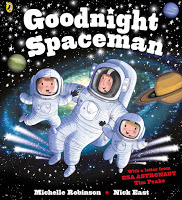 Not a bad effort.
Not a bad effort.
 Not even Julia Donaldson.
Michelle Robinson's latest book, 'Goodnight Spaceman' is out on April 7th. She has many events scheduled this year and has a few of her own unique fears:-
Not even Julia Donaldson.
Michelle Robinson's latest book, 'Goodnight Spaceman' is out on April 7th. She has many events scheduled this year and has a few of her own unique fears:-
Everyone will be disappointed that I am not Tim Peake.If Tim Peake were watching my event from space, he would be disappointed.They only invited me because they are hoping I can introduce them to Tim Peake. Disappointment is inevitable.
'Goodnight Spaceman' is published by Puffin, illustrated by Nick East and features a very special foreword by ESA astronaut, Tim Peake.
Event coming up? Worried you’ll forget to WORRY about something? Fret no more. This handy checklist of unnecessary anxieties is guaranteed to have you losing sleep for weeks.I will not find the venue.
 Not even on the map.I will find the venue is insalubrious.I will turn up on the wrong day/week/month/continent.My car will break down or else I will crash it. Probably into the venue. Or the children.The train will be cancelled. The train will break down. I will crash the train.I will be late. I will be flustered. Everything will go wrong.I will be early. I will still be flustered,. There will be no excuse for anything to go wrong, and yet absolutely everything will.I will have to cancel due to crippling anxiety and/or illness. I will let everyone down. I will damage my reputation and no on will ever ask me to do an event again. Fingers crossed.The promised essentials (powerpoint, flip chart, paper, pens, valium, etc.) will not materialise.I will leave my books at home.I will leave my memory stick at home with my slideshow on it.I will remember the memory stick, but will bring the wrong file, most likely something inappropriate or incriminating.The event organiser will be unable to conceal their disappointment in me.The children will boo and chant, “WE WANT THE GRUFFALO.”I will have to read ‘The Gruffalo.’No one will turn up.
Not even on the map.I will find the venue is insalubrious.I will turn up on the wrong day/week/month/continent.My car will break down or else I will crash it. Probably into the venue. Or the children.The train will be cancelled. The train will break down. I will crash the train.I will be late. I will be flustered. Everything will go wrong.I will be early. I will still be flustered,. There will be no excuse for anything to go wrong, and yet absolutely everything will.I will have to cancel due to crippling anxiety and/or illness. I will let everyone down. I will damage my reputation and no on will ever ask me to do an event again. Fingers crossed.The promised essentials (powerpoint, flip chart, paper, pens, valium, etc.) will not materialise.I will leave my books at home.I will leave my memory stick at home with my slideshow on it.I will remember the memory stick, but will bring the wrong file, most likely something inappropriate or incriminating.The event organiser will be unable to conceal their disappointment in me.The children will boo and chant, “WE WANT THE GRUFFALO.”I will have to read ‘The Gruffalo.’No one will turn up.
 Not even remotely likely.Everyone will turn up.Johnny Depp will turn up and I will not be able to think of the first thing to say to him.Nose bleed.Panic attack.Fainting.Sudden inexplicable onset of Tourette’s. Earthquake.Volcano.Tsunami.Alien invasion.Brain drain.Someone will look at me funny, putting me off my stride so badly I launch involuntarily into a musical number from Grease.The children will be Mensa protégés who correct me on my grammar.A child will ask a question that destroys or unhinges me.I will fall flat on my face. I will catch shingles from lingering pox on the venue carpet.These are pre-school children. I could even catch bubonic plague.The organiser will not have arranged book sales.
Not even remotely likely.Everyone will turn up.Johnny Depp will turn up and I will not be able to think of the first thing to say to him.Nose bleed.Panic attack.Fainting.Sudden inexplicable onset of Tourette’s. Earthquake.Volcano.Tsunami.Alien invasion.Brain drain.Someone will look at me funny, putting me off my stride so badly I launch involuntarily into a musical number from Grease.The children will be Mensa protégés who correct me on my grammar.A child will ask a question that destroys or unhinges me.I will fall flat on my face. I will catch shingles from lingering pox on the venue carpet.These are pre-school children. I could even catch bubonic plague.The organiser will not have arranged book sales.
 Not even possible, really.The organiser will expect me to bring along books and cash float. They will also expect me to do maths while talking and signing books for children with names like, "Eve, spelled Yvxwezfgh."I will not sell a single book and everyone will know I am a loser.No one will offer me a drink all day.Someone will offer me a drink but I will start choking on it, mid-story.I will choke to death in front of everybody.I will not be able to locate the loo.I will have an accident.Looking for the loo, I will enter the broom cupboard and have to style it out.…resulting in a request to read ‘Room on the Broom.’My family will resent me for spending time away from home.My children will forget what I look like.My husband will think I am away so much I must be having an affair.I will go all that way and - assuming #18 did not happen - there will not be anyone worth having an affair with.No one would want to have an affair with me anyway: I arrive a witless, charmless mess dressed as an impoverished bag lady.A local newspaper journalist will come and take a horrible photo, capturing my dishevelled bag lady look forever and making it the most prominent image result for me in Google.The photo will appear in the paper with the caption, ‘Not even Julia Donaldson’.
Not even possible, really.The organiser will expect me to bring along books and cash float. They will also expect me to do maths while talking and signing books for children with names like, "Eve, spelled Yvxwezfgh."I will not sell a single book and everyone will know I am a loser.No one will offer me a drink all day.Someone will offer me a drink but I will start choking on it, mid-story.I will choke to death in front of everybody.I will not be able to locate the loo.I will have an accident.Looking for the loo, I will enter the broom cupboard and have to style it out.…resulting in a request to read ‘Room on the Broom.’My family will resent me for spending time away from home.My children will forget what I look like.My husband will think I am away so much I must be having an affair.I will go all that way and - assuming #18 did not happen - there will not be anyone worth having an affair with.No one would want to have an affair with me anyway: I arrive a witless, charmless mess dressed as an impoverished bag lady.A local newspaper journalist will come and take a horrible photo, capturing my dishevelled bag lady look forever and making it the most prominent image result for me in Google.The photo will appear in the paper with the caption, ‘Not even Julia Donaldson’.
 Not even my book.The photo will not appear, being deemed less newsworthy than a sponsored shoeshine. My publishers will not even notice that I am hauling my arse all over the country to promote our book.My publishers will notice, but will be too busy celebrating the umpteenth reprint of ‘The Gruffalo' to care.My publishers will see the terrible national newspaper write-up with the unfortunate photo of me, book aloft, smiling, beside the burning venue and sobbing children.There will not be cake.There will be cake, but I will choke on it.Repeat anxiety #39.They will ring to cancel when I am five minutes away because, “We thought you had written ‘The Gruffalo'.”Julia Donaldson will turn up, dressed as the Gruffalo, and deck me.Some manner of very public, non-choking related death.I’m worried I’ve omitted a load of things I ought to be worrying about. Please share any fears I’ve yet to consider below. Don't worry, folks. You'll be great. After all, you’ve got this anxiety thing nailed.
Not even my book.The photo will not appear, being deemed less newsworthy than a sponsored shoeshine. My publishers will not even notice that I am hauling my arse all over the country to promote our book.My publishers will notice, but will be too busy celebrating the umpteenth reprint of ‘The Gruffalo' to care.My publishers will see the terrible national newspaper write-up with the unfortunate photo of me, book aloft, smiling, beside the burning venue and sobbing children.There will not be cake.There will be cake, but I will choke on it.Repeat anxiety #39.They will ring to cancel when I am five minutes away because, “We thought you had written ‘The Gruffalo'.”Julia Donaldson will turn up, dressed as the Gruffalo, and deck me.Some manner of very public, non-choking related death.I’m worried I’ve omitted a load of things I ought to be worrying about. Please share any fears I’ve yet to consider below. Don't worry, folks. You'll be great. After all, you’ve got this anxiety thing nailed.  Not a bad effort.
Not a bad effort.
 Not even Julia Donaldson.
Michelle Robinson's latest book, 'Goodnight Spaceman' is out on April 7th. She has many events scheduled this year and has a few of her own unique fears:-
Not even Julia Donaldson.
Michelle Robinson's latest book, 'Goodnight Spaceman' is out on April 7th. She has many events scheduled this year and has a few of her own unique fears:-
Everyone will be disappointed that I am not Tim Peake.If Tim Peake were watching my event from space, he would be disappointed.They only invited me because they are hoping I can introduce them to Tim Peake. Disappointment is inevitable.
'Goodnight Spaceman' is published by Puffin, illustrated by Nick East and features a very special foreword by ESA astronaut, Tim Peake.
Published on March 28, 2016 00:40
March 21, 2016
Getting on board with board books by Jane Clarke
In the past, I've nearly always bought picture books as paperbacks, occasionally buying a hardback copy of a book I love in the hope of preserving it for posterity.
All that has changed with the arrival of my two baby granddaughters. Sammy is 1 year old this week and Angelina turns 2 next month. They both love books. They love being read to - but they also love turning the pages (in any order), bashing the book, trying to pick the illustrations out of it and chewing and dribbling on the pages.
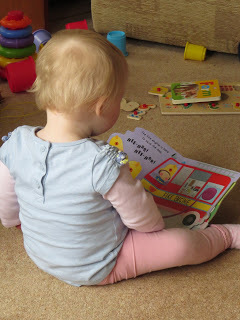
It’s a joy seeing them interact with books, but it doesn’t do the pages of a conventional picture book much good, especially when they’re also being shared with a puppy.
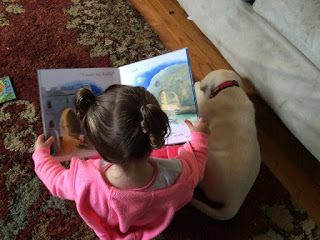
So, recently, I’ve found myself buying board books. Board books specifically written and designed for the under 3s tend to have simpler text, not so many pages and not as much story as picture books. These delight my granddaughters, and I’ve loved writing some of them myself, but (whisper it) they’re often not such a satisfying read for the adult as a good picture book is.
Happily, lots of classic picture books are available in board form, and some (but not all) work really well in this format. I couldn’t resist getting some I read to my boys when they were small.The corners get a big splayed out and soggy, but they survive much better than the paperbacks ever did.

I’d love to hear what picture books you think work well as board books, so I can add to my collection.
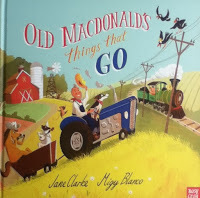 Jane’s latest picture book Old Macdonald’s Things that Go, illustrated by Migy Blanco.Out this month in hardback in the UK.
Jane’s latest picture book Old Macdonald’s Things that Go, illustrated by Migy Blanco.Out this month in hardback in the UK.
Jane's four very yummy and chewable board books,tastily illustrated by Georgie Birkett.
All that has changed with the arrival of my two baby granddaughters. Sammy is 1 year old this week and Angelina turns 2 next month. They both love books. They love being read to - but they also love turning the pages (in any order), bashing the book, trying to pick the illustrations out of it and chewing and dribbling on the pages.

It’s a joy seeing them interact with books, but it doesn’t do the pages of a conventional picture book much good, especially when they’re also being shared with a puppy.

So, recently, I’ve found myself buying board books. Board books specifically written and designed for the under 3s tend to have simpler text, not so many pages and not as much story as picture books. These delight my granddaughters, and I’ve loved writing some of them myself, but (whisper it) they’re often not such a satisfying read for the adult as a good picture book is.
Happily, lots of classic picture books are available in board form, and some (but not all) work really well in this format. I couldn’t resist getting some I read to my boys when they were small.The corners get a big splayed out and soggy, but they survive much better than the paperbacks ever did.

I’d love to hear what picture books you think work well as board books, so I can add to my collection.
 Jane’s latest picture book Old Macdonald’s Things that Go, illustrated by Migy Blanco.Out this month in hardback in the UK.
Jane’s latest picture book Old Macdonald’s Things that Go, illustrated by Migy Blanco.Out this month in hardback in the UK. Jane's four very yummy and chewable board books,tastily illustrated by Georgie Birkett.

Published on March 21, 2016 00:00
March 14, 2016
Picture a yellow square rotating towards you... picturing things, aphantasia and reading and writing picture books by Juliet Clare Bell
When I was a child, we used to play this game: my dad would tell us all to shut our eyes in the car when we weren’t too far from home and then he’d drive and –still with our eyes shut- we’d have to tell him when we were home. To me, it was a bit like magic. The car would eventually stop and I’d assume we were home –because we’d stopped. But my sister would confidently say, eyes still shut: “You’ve cheated! You’ve taken us down Monks Hill instead! We’re by the field!” And she’d be right. How on earth did she know?
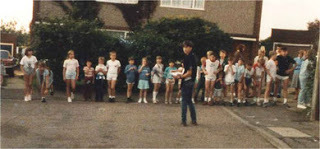 (This is where we should have ended up, outside our house -pictured here with some siblings and neighbours...)
(This is where we should have ended up, outside our house -pictured here with some siblings and neighbours...)
I was always getting lost, and had to accept that although I could do really well on certain things and tests, there were some things that other people found easy that for me were impossible, like those puzzles where you had to move the squares around to un-jumble a picture,
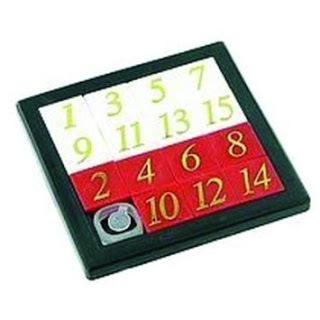 (I actually had this one as a child. What cruel trick to be given something like this...)
(I actually had this one as a child. What cruel trick to be given something like this...)or work out which of a group of drawn objects were actually the same but rotated (?!)
 (I was one of those children who actually loved IQ tests and maths tests, but these questions were impossible.)
(I was one of those children who actually loved IQ tests and maths tests, but these questions were impossible.)and worst of all, and obviously designed to make me feel way more stressed than I ever was about anything else, those 3D wooden puzzles that you took apart and were then meant to reassemble. As someone who found lots of things easy as a child, these things could turn me into a jibbering wreck...
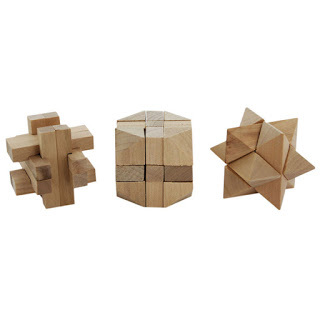 (Even looking at that middle one now -we had one the same at home- is making my heart race.)
(Even looking at that middle one now -we had one the same at home- is making my heart race.)It wasn’t until I was seventeen and travelling home from college on the train with a friend that I made a crazy discovery…
We were just chatting and my friend said: “Close your eyes and picture a yellow square rotating towards you…” I didn’t know what she meant, so she repeated it. What on earth did ‘picturing’ mean? I’d always assumed that it was a metaphor. Turns out…
…other people could picture things when they closed their eyes! How totally, utterly, bafflingly weird was that? Except that other people seemed to find it as bafflingly weird that I didn’t...
So it turned out that other people could picture their mum if they closed their eyes and she wasn’t actually there.
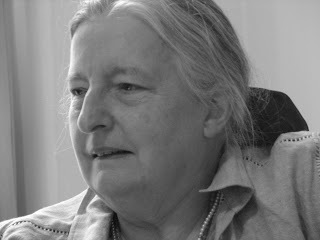 (My mum. Who knew you could close your eyes and see the kinds of things you could see when you looked at photos, or the world around you?)
(My mum. Who knew you could close your eyes and see the kinds of things you could see when you looked at photos, or the world around you?)And, as my sister who used to know where we were going in the car even with her eyes shut, told me, when she's working out where she's going, she pictures a map from above, like an aerial view of streets (excuse me?) when she’s walking around.
I’d never read anything about this until a couple of months ago when a fellow writer, Addy Farmer, wrote about it. She mentioned the famous 19th century psychologist, Galton, who’d done some research into this and found that people who pictured things just assumed other people pictured things, and people who didn’t, didn’t (well –it would never even cross their minds that something that bizarre was going on in other people’s heads).
Not picturing things is called aphantasia (which sounds a little too close to an 80s pop group for my liking), and you can do a quiz here (run by researchers at Exeter University, who are doing research into it). For me, most of the questions didn’t even make sense.
I’ve had very visual people feel sorry for me –but I’ve never known any different, and I don't feel like it's been difficult without. When I went to university and for a long time after, I used to have a wall plastered with photos of people that I was no longer living with/seeing all the time, which gave me enormous pleasure and I’d really look at them every day so I was still seeing them even if I was doing it in a different way from other people (not that it ever crossed my mind back then why I did this). I love chatting with other people so asking for directions is hardly a chore. My auditory memory was great –it was easy to learn lines, remember all the lyrics to songs, recount the whole of the previous night’s Neighbours(bad accents ’n all) to people in school who’d not seen it…
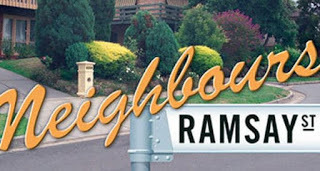 (My auditory memory was great, and it was useful when someone else had missed the previous night's episode of Neighbours...)
(My auditory memory was great, and it was useful when someone else had missed the previous night's episode of Neighbours...)And a recent long discussion with a friend about it has made me realise that it’s probably informed how I view my life. My friend relives arguments and difficult moments –and nice moments- over and over again, vividly, with visual detail –and it’s not always in her control to stop seeing things that she doesn’t want to see…
And so aphantasia probably helps me live more in the present and let go of the past: although it was extremely sad when my husband and I were going to split up (and the run up to it, when I was living it every day was extremely painful), I’m never haunted by closing my eyes and seeing pictures of us being happy together. If I don’t look at pictures of him, I don’t see him. And I still don’t know what colour his eyes are, even though I’ve looked into them thousands of times. I still remember the happy emotions associated with lots of the relationship, so I can talk genuinely happily with the children about some of the great times we had together –but I don’t visualise them. And I’d never be haunted by imagined images of him with someone new, which apparently other people are, which must be grim. Similarly, I don’t visualise being attacked by someone in my mid-twenties and I can't remember what he looked like at all. And it probably partly accounts for my being less bothered by my appearance than some people (unless I’m in front of a mirror, it wouldn’t cross my mind how someone else might be viewing me –unless I actively tried to think about it). And I don't crave expensive exotic holidays. They’d be lovely whilst I was there, I suspect –and I'd love hanging out with the people I was with, but I wouldn't be reliving any beautiful sights again. For me, grass just isn’t greener on the other side. You make the most of exactly where you’re at because the other stuff is kind of not even there… it seems that for some other people, the If onlys… and what ifs… are far more present. And I probably have my lack of visual imagination to thank for a large part of that.
But there is a point to this in relation to reading and writing and picture books.I love books and reading. At the end of reading a book I have no more idea what a character looks like than at the beginning. I skip descriptive passages because they mean nothing. Although I love her poetry (which for me is about the words and the sounds and the emotion), I could never read Emily Bronte’s Wuthering Heights as it’s so full of description I just can’t follow it.
Does this matter? Not to me –I love books which resonate with me emotionally; physical description is irrelevant for that. And there are so many different kinds of book that there are always going to be loads that I’d love. And whether or not it’s coincidental (I suspect not), it turns out that the author of one of my favourite books (Tall Story), Candy Gourlay, doesn’t picture things either…
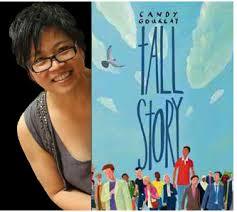 (Candy doesn't visualise things, either. And her books are fab.)
(Candy doesn't visualise things, either. And her books are fab.)So how does this tie in with writing picture books? I love picture books, especially where a lot of the story is told through the pictures, like:
Not Now, Bernard, by David McKee
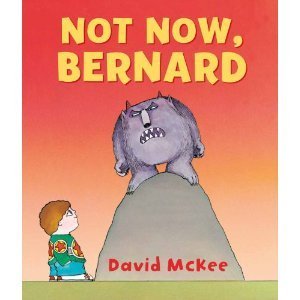
and The Baby That Roared by Simon Puttock and Nadia Shireen
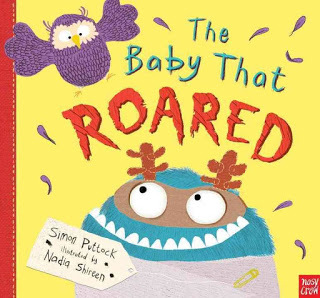
and Oh No, George! by Chris Haughton
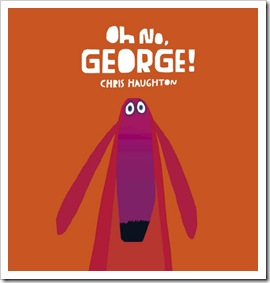
And that’s great –and easy, as I can just look at the pictures and they’re there.But for picture book writers who don’t visualise things but still love to write books where as yet un-drawn images are a really important part of the story, how does that work? I’d love to hear from other picture book writers as to how they do it and whether most of them visualise the image. I don’t know how it works with me but I do know that I can easily leave space for the pictures when I'm writing, and that I love doing it. Do I imagine what that picture would look like? Well I guess I do in a way –I think that it would need to contain certain things. Do I visualise it? No. But I would know that it needed to reveal a specific thing that’s not yet been mentioned in the text, or show an emotional reunion –just without knowing what that scene would look like. And that’s the illustrator’s job anyway…
Maybe I love picture books so much because I’m not visual. Picture books are a visual experience for me whereas reading a novel certainly isn’t a vaguely visual experience… I’d love to hear from other writers and illustrators about how important picturing things is for them –is it real or just a metaphor? And for readers, what’s your experience of reading books? I’d love to know the kinds of books that other non-visual people like to read –and what they like to write. Please share your visual or non-visual experiences below.
Let's finish by celebrating our differences. Loads of things go into what we choose to write and how we write it. Picturing things may be part of how some people write, but so might not picturing things. I certainly wouldn't consider it a disadvantage...
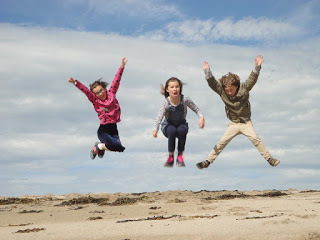
Hooray for the different way different writers think... (with thanks to my jumping children)
Thank you.
Juliet Clare Bell’s first true story picture book, Two Brothers and a Chocolate Factory: The Remarkable Story of Richard and George Cadbury, illustrated by Jess Mikhail, is out on March 19th. Her last book, The Unstoppable Maggie McGee (illustrated by Dave Gray) has raised over £40,000 in sales so far for Birmingham Children’s Hospital’s Magnolia House Appeal. www.julietclarebell.com
Published on March 14, 2016 04:37
March 6, 2016
TO BOLDY GO: Picture books in space • Jonathan Emmett
As someone who grew up at the time of the Apollo Missions I’ve always found the idea of space travel hugely appealing and had a particular interest in stories that are set in space.
I've pitched several space-set stories to publishers over the years. However, while I’ve had some success getting space-set chapter fiction published …
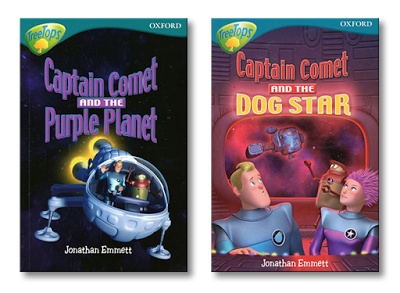 The Captain Comet chapter fiction books illustrated by Andy Parker are set in space.
The Captain Comet chapter fiction books illustrated by Andy Parker are set in space.
… none of the space-set picture books I’ve pitched have ever made it into print.
 An art sample illustrator Steve Cox put together for Invasion of the Botty Snatchers,
An art sample illustrator Steve Cox put together for Invasion of the Botty Snatchers,
an unpublished space-set picture book we developed together.
Of course this could be because none of them were any good, but when another of my space-set picture book ideas was turned down last year, the publisher told me that one of the reasons was that, “picture books set in space generally don’t sell.”
If this is true, then I think it shows that the picture book market is currently catering to the tastes of a demographic that is relatively narrow compared to it's potential readership. There are plenty of picture book age children that are interested in stories set in space. However these children are currently having this appetite fed by TV shows and films rather than books. My son and several of his friends were obsessed with the original U certificate Star Wars trilogy from the age of four and when I went to see the new Star Wars film over Christmas, I was struck by how many parents had brought small children to see it, despite its 12 certificate rating.
If publishers want to show these children that picture books are every bit as capable of matching the appeal of their favourite films and TV shows, they might consider “boldly going” into space a little more often. And I do mean “boldly”; it’s not just the setting that’s important. There is a market for gentler picture book stories set in space, but such books will not cut it with young readers with an appetite for dogfights and death stars. These children need picture books that can match the dastardly villainy, thrillingly perilous predicaments and sophisticated craft and weaponry evident in films like Star Wars.
Here are three space-set books that are a good deal “bolder” than most.
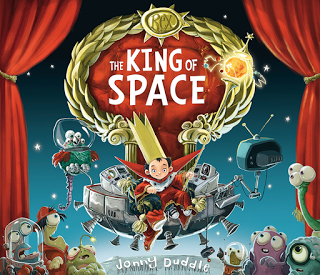
The King of Space written and Illustrated by Jonny Duddle is one of the best picture books of the last ten years and shamefully under-recognised by reviewers and awards judges alike. It’s a brilliantly illustrated, tech-tastic, action packed epic, filled with battling spaceships, menacing robots and a pint-sized megalomaniac.

The hardback edition comes with a dust-cover that unfolds to make this awesome poster of a 'warbot'.
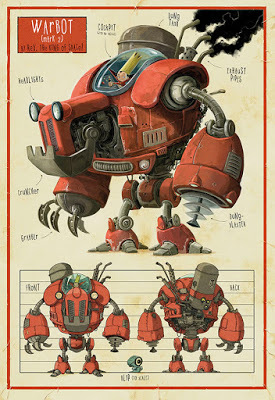
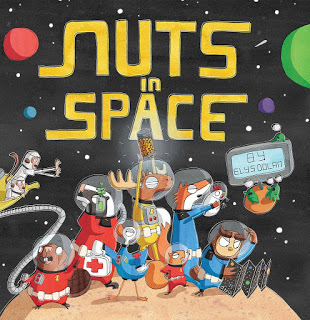
Nuts in Space written and illustrated by Elys Dolan is a madcap space epic that's brimful of comic references to both Star Wars and Star Trek. Charged with transporting “The Lost Nuts of Legend” across the galaxy, the crew of Forest Fleet’s finest starship encounter a mischievous menagerie of creatures from little green men to ravenous Ewok-like bears, before falling into the clutches of Daft Monkey and his legion of simian stormtroopers.
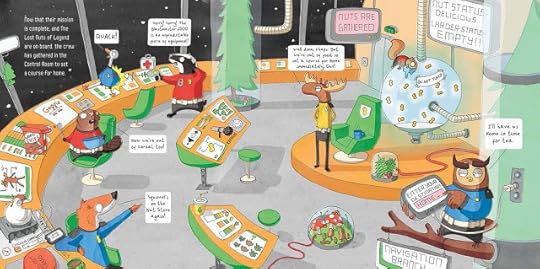
The book is full of amusing in-jokes for sci-fi fans young and old, such as this encounter between Daft Monkey and Commander Moose.
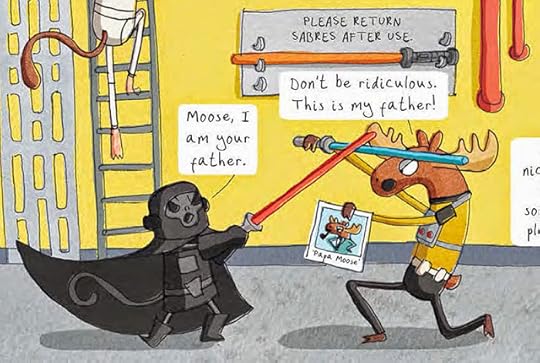
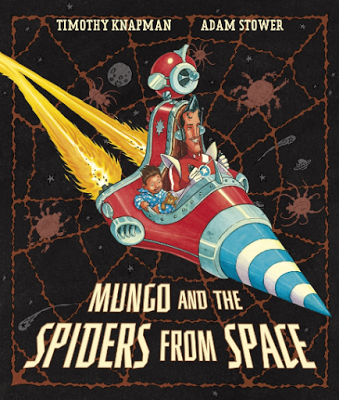
Mungo and the Spiders from Space written by Timothy Knapman, illustrated by Adam Stower is part of an excellent series of Mungo stories in which Mungo, the young hero, enters the world of a favourite bedtime book. In this story it's a comic book adventure featuring a Dan-Dare-like space hero called Captain Galacticus.

Galacticus and Mungo join forces to thwart the villainous, Dr Frankenstinker, the "maddest scientist on Mercury".
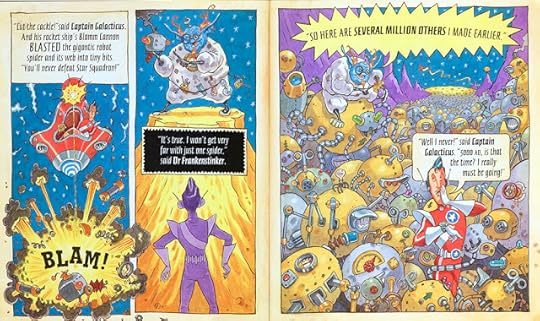
Can you recommend any other picture books that "boldly go" into space? If so, we'd love to hear about them in the comments box below.
 Jonathan Emmett's latest picture book is
Fast and Furry Racers: The Silver Serpent Cup
illustrated by Ed Eaves and published by Oxford University Press.
Jonathan Emmett's latest picture book is
Fast and Furry Racers: The Silver Serpent Cup
illustrated by Ed Eaves and published by Oxford University Press.
Find out more about Jonathan and his books at his Scribble Street web site or his blog. You can also follow Jonathan on Facebook and Twitter @scribblestreet.
See all of Jonathan's posts for Picture Book Den.
I've pitched several space-set stories to publishers over the years. However, while I’ve had some success getting space-set chapter fiction published …
 The Captain Comet chapter fiction books illustrated by Andy Parker are set in space.
The Captain Comet chapter fiction books illustrated by Andy Parker are set in space.… none of the space-set picture books I’ve pitched have ever made it into print.
 An art sample illustrator Steve Cox put together for Invasion of the Botty Snatchers,
An art sample illustrator Steve Cox put together for Invasion of the Botty Snatchers,an unpublished space-set picture book we developed together.
Of course this could be because none of them were any good, but when another of my space-set picture book ideas was turned down last year, the publisher told me that one of the reasons was that, “picture books set in space generally don’t sell.”
If this is true, then I think it shows that the picture book market is currently catering to the tastes of a demographic that is relatively narrow compared to it's potential readership. There are plenty of picture book age children that are interested in stories set in space. However these children are currently having this appetite fed by TV shows and films rather than books. My son and several of his friends were obsessed with the original U certificate Star Wars trilogy from the age of four and when I went to see the new Star Wars film over Christmas, I was struck by how many parents had brought small children to see it, despite its 12 certificate rating.
If publishers want to show these children that picture books are every bit as capable of matching the appeal of their favourite films and TV shows, they might consider “boldly going” into space a little more often. And I do mean “boldly”; it’s not just the setting that’s important. There is a market for gentler picture book stories set in space, but such books will not cut it with young readers with an appetite for dogfights and death stars. These children need picture books that can match the dastardly villainy, thrillingly perilous predicaments and sophisticated craft and weaponry evident in films like Star Wars.
Here are three space-set books that are a good deal “bolder” than most.

The King of Space written and Illustrated by Jonny Duddle is one of the best picture books of the last ten years and shamefully under-recognised by reviewers and awards judges alike. It’s a brilliantly illustrated, tech-tastic, action packed epic, filled with battling spaceships, menacing robots and a pint-sized megalomaniac.

The hardback edition comes with a dust-cover that unfolds to make this awesome poster of a 'warbot'.


Nuts in Space written and illustrated by Elys Dolan is a madcap space epic that's brimful of comic references to both Star Wars and Star Trek. Charged with transporting “The Lost Nuts of Legend” across the galaxy, the crew of Forest Fleet’s finest starship encounter a mischievous menagerie of creatures from little green men to ravenous Ewok-like bears, before falling into the clutches of Daft Monkey and his legion of simian stormtroopers.

The book is full of amusing in-jokes for sci-fi fans young and old, such as this encounter between Daft Monkey and Commander Moose.


Mungo and the Spiders from Space written by Timothy Knapman, illustrated by Adam Stower is part of an excellent series of Mungo stories in which Mungo, the young hero, enters the world of a favourite bedtime book. In this story it's a comic book adventure featuring a Dan-Dare-like space hero called Captain Galacticus.

Galacticus and Mungo join forces to thwart the villainous, Dr Frankenstinker, the "maddest scientist on Mercury".

Can you recommend any other picture books that "boldly go" into space? If so, we'd love to hear about them in the comments box below.
 Jonathan Emmett's latest picture book is
Fast and Furry Racers: The Silver Serpent Cup
illustrated by Ed Eaves and published by Oxford University Press.
Jonathan Emmett's latest picture book is
Fast and Furry Racers: The Silver Serpent Cup
illustrated by Ed Eaves and published by Oxford University Press.Find out more about Jonathan and his books at his Scribble Street web site or his blog. You can also follow Jonathan on Facebook and Twitter @scribblestreet.
See all of Jonathan's posts for Picture Book Den.
Published on March 06, 2016 23:00
March 1, 2016
Is this the real life or is this just fantasy? by Abie Longstaff
I love fantasy - any kind of fairy tales, mythology or crazy invented wackiness.
But I also chortle when a book manages to reference real life.
I loved the use of 'Henopoly' in Chicken Nugget (Michelle Robinson and Tom McLaughlin)
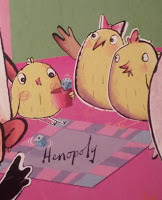
This poster in Spaghetti with the Yeti (Charlotte Gillain, Adam Gillain and Lee Wildish) made me laugh with its X Files reference:
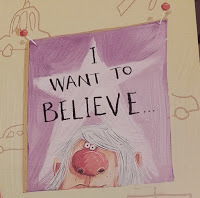
And who could fail to giggle at a line of royal underpants in The Queen's Knickers (Nicholas Allan)?
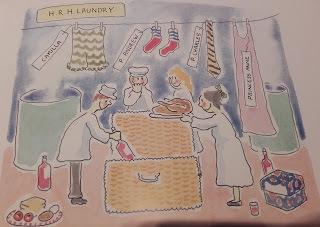
Lauren Beard and I try to squeeze as many real life references as we can into our fairy tales. In the latest Fairytale Hairdresser, Beauty and the Beast, we've got:
Art references:

Literary references:
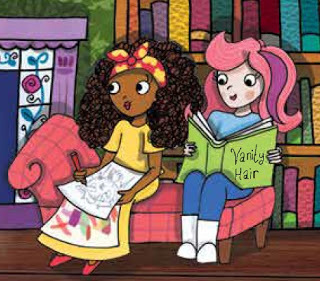
And even a nod to musical genres

But can you guess which musical style/performer each outfit represents? And, more importantly, can you please settle the row between my husband and me - is Number 1 Rude Boy or Pete Docherty?
But I also chortle when a book manages to reference real life.
I loved the use of 'Henopoly' in Chicken Nugget (Michelle Robinson and Tom McLaughlin)

This poster in Spaghetti with the Yeti (Charlotte Gillain, Adam Gillain and Lee Wildish) made me laugh with its X Files reference:

And who could fail to giggle at a line of royal underpants in The Queen's Knickers (Nicholas Allan)?

Lauren Beard and I try to squeeze as many real life references as we can into our fairy tales. In the latest Fairytale Hairdresser, Beauty and the Beast, we've got:
Art references:

Literary references:

And even a nod to musical genres

But can you guess which musical style/performer each outfit represents? And, more importantly, can you please settle the row between my husband and me - is Number 1 Rude Boy or Pete Docherty?
Published on March 01, 2016 04:55
February 21, 2016
Picture Books For All, by Pippa Goodhart
A lot of us are lucky enough to remember the joy of sitting snug in bed as a parent read us a bedtime picture book, and also know the joy of being that adult performing the picture book text for an eager child audience. Those of us in the book world tend to have taken that relationship between an adult reading the text to a child who is looking carefully at the pictures while they listen for granted.
But there are many adults who find reading hard. What if the adult can’t read the text? Can’t enjoy that bond that comes from reading and sharing a book with their children?
In recent years there has been a lot of work done to create what are known as high/low books (higher age interest level together with a lower age reading ability) to help children and adults who struggle to read books to themselves. But nobody had given much thought to the parents who want to read to their children but find reading picture books out loud too much of a challenge.
Designers often play with text in picture books, working it through illustrative images, varying font size and style to make it express the text meaning, sometimes expecting the reader to jump from text at the top of a spread to text at the bottom, then up to the top of the facing page. All those things can work well for the able reader, but they become obstacles to reading if you are somebody who finds reading hard, perhaps because you are dyslexic and never learned to read fluently at school, perhaps because English isn’t your first language.
So Barrington Stoke have come up with a series of picture books that are designed to be read easily by children and adults alike. What makes them easier to read?
Pages that are a tinted cream background rather than the stark white that can make reading hard if you’re dyslexic.Text laid out left to right, top to bottom.A font that is clear, reader-friendly, and consistent.Writing that doesn’t introduce made-up strange words that have to be worked out.
Does any of that that mean that these are dull books? Far from it!
These are rather sophisticated picture books, aimed at children of, say, seven plus. Their stories challenge in a way that you might not want a book for the usual picture book audience of 2-5 year olds to be challenged.

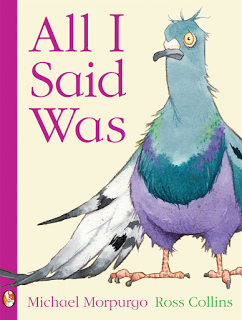
‘All I Said Was’, by Michael Morpurgo and Ross Collins is a short tale, showing and telling how a boy who swapped his life for that of a pigeon begins to regret that swap when he gets mobbed by crows … but when he returns home, the pigeon who is now a boy won’t swap back. Rather as the child in Roald Dahl’s Witches is left stuck as a mouse at the end of that book, this book too leaves a bleak and seemingly hopeless ending for the boy. Food for thought, and a bit of thrilling horror, all in twelve spreads of illustration and a short text!
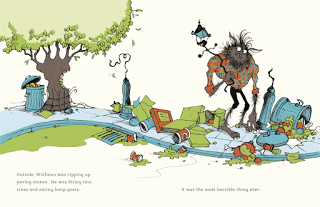
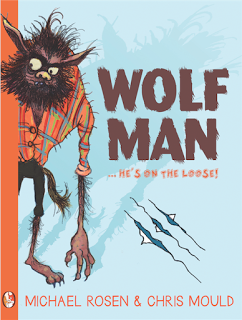
‘Wolf Man’ by Michael Rosen and Chris Mould plays with fear as a scary manic-looking Wolfman runs amok through a town, scaring even the army and the chief of police … until the tension is brilliantly cut with a typical Michael Rosen joke of a kind which children will find hilarious! This book has slash marks, and real holes, in it’s cover, presumably made by the Wolfman’s claws. Books can be exciting!
There are more of these Picture Squirrel books out there, all combining top illustrators and writers, all of them quality books. Hooray that one publisher has woken up to the need for excellent accessible picture books for parents and children to share.
Do look at this whole series of books and more on the Barrington Stoke website by clicking here
Published on February 21, 2016 23:42
Picture Books For All, by Pippa Goodhart
A lot of us are lucky enough to remember the joy of sitting snug in bed as a parent read us a bedtime picture book, and also know the joy of being that adult performing the picture book text for an eager child audience. Those of us in the book world tend to have taken that relationship between an adult reading the text to a child who is looking carefully at the pictures while they listen for granted.
But there are many adults who find reading hard. What if the adult can’t read the text? Can’t enjoy that bond that comes from reading and sharing a book with their children?
In recent years there has been a lot of work done to create what are known as high/low books (higher age interest level together with a lower age reading ability) to help children and adults who struggle to read books to themselves. But nobody had given much thought to the parents who want to read to their children but find reading picture books out loud too much of a challenge.
Designers often play with text in picture books, working it through illustrative images, varying font size and style to make it express the text meaning, sometimes expecting the reader to jump from text at the top of a spread to text at the bottom, then up to the top of the facing page. All those things can work well for the able reader, but they become obstacles to reading if you are somebody who finds reading hard, perhaps because you are dyslexic and never learned to read fluently at school, perhaps because English isn’t your first language.
So Barrington Stoke have come up with a series of picture books that are designed to be read easily by children and adults alike. What makes them easier to read?-Pages that are a tinted cream background rather than the stark white that can make reading hard if you’re dyslexic. -Text laid out left to right, top to bottom.- A font that is clear, reader-friendly, and consistent.- Writing that doesn’t introduce made-up strange words that have to be worked out.
Does any of that that mean that these are dull books? Far from it!
These are rather sophisticated picture books, aimed at children of, say, seven plus. Their stories challenge in a way that you might not want a book for the usual picture book audience of 2-5 year olds to be challenged.
‘All I Said Was’, by Michael Morpurgo and Ross Collins is a short tale, showing and telling how a boy who swapped his life for that of a pigeon begins to regret that swap when he gets mobbed by crows … but when he returns home, the pigeon who is now a boy won’t swap back. Rather as the child in Roald Dahl’s Witches is left stuck as a mouse at the end of that book, this book too leaves a bleak and seemingly hopeless ending for the boy. Food for thought, and a bit of thrilling horror, all in twelve spreads of illustration and a short text!
‘Wolf Man’ by Michael Rosen and Chris Mould plays with fear as a scary manic-looking Wolfman runs amok through a town, scaring even the army and the chief of police … until the tension is brilliantly cut with a typical Michael Rosen joke of a kind which children will find hilarious! This book has slash marks, and real holes, in it’s cover, presumably made by the Wolfman’s claws. Books can be exciting!
There are more of these Picture Squirrel books out there, all combining top illustrators and writers, all of them quality books. Hooray that one publisher has woken up to the need for excellent accessible picture books for parents and children to share.
Apologies for the lack of pictures in this blog. I've tried and failed to import pictures in various different ways, but will keep trying! Meanwhile, do look at this whole series of books and more on the Barrington Stoke website: http://www.barringtonstoke.co.uk/abou...
But there are many adults who find reading hard. What if the adult can’t read the text? Can’t enjoy that bond that comes from reading and sharing a book with their children?
In recent years there has been a lot of work done to create what are known as high/low books (higher age interest level together with a lower age reading ability) to help children and adults who struggle to read books to themselves. But nobody had given much thought to the parents who want to read to their children but find reading picture books out loud too much of a challenge.
Designers often play with text in picture books, working it through illustrative images, varying font size and style to make it express the text meaning, sometimes expecting the reader to jump from text at the top of a spread to text at the bottom, then up to the top of the facing page. All those things can work well for the able reader, but they become obstacles to reading if you are somebody who finds reading hard, perhaps because you are dyslexic and never learned to read fluently at school, perhaps because English isn’t your first language.
So Barrington Stoke have come up with a series of picture books that are designed to be read easily by children and adults alike. What makes them easier to read?-Pages that are a tinted cream background rather than the stark white that can make reading hard if you’re dyslexic. -Text laid out left to right, top to bottom.- A font that is clear, reader-friendly, and consistent.- Writing that doesn’t introduce made-up strange words that have to be worked out.
Does any of that that mean that these are dull books? Far from it!
These are rather sophisticated picture books, aimed at children of, say, seven plus. Their stories challenge in a way that you might not want a book for the usual picture book audience of 2-5 year olds to be challenged.
‘All I Said Was’, by Michael Morpurgo and Ross Collins is a short tale, showing and telling how a boy who swapped his life for that of a pigeon begins to regret that swap when he gets mobbed by crows … but when he returns home, the pigeon who is now a boy won’t swap back. Rather as the child in Roald Dahl’s Witches is left stuck as a mouse at the end of that book, this book too leaves a bleak and seemingly hopeless ending for the boy. Food for thought, and a bit of thrilling horror, all in twelve spreads of illustration and a short text!
‘Wolf Man’ by Michael Rosen and Chris Mould plays with fear as a scary manic-looking Wolfman runs amok through a town, scaring even the army and the chief of police … until the tension is brilliantly cut with a typical Michael Rosen joke of a kind which children will find hilarious! This book has slash marks, and real holes, in it’s cover, presumably made by the Wolfman’s claws. Books can be exciting!
There are more of these Picture Squirrel books out there, all combining top illustrators and writers, all of them quality books. Hooray that one publisher has woken up to the need for excellent accessible picture books for parents and children to share.
Apologies for the lack of pictures in this blog. I've tried and failed to import pictures in various different ways, but will keep trying! Meanwhile, do look at this whole series of books and more on the Barrington Stoke website: http://www.barringtonstoke.co.uk/abou...
Published on February 21, 2016 23:42
February 15, 2016
Rummaging and Ruminating - Jonathan Allen
 Stamps! How cool is that?
Stamps! How cool is that?I was recently contacted by a relative of the late, great Margaret Mahy, asking if I had any of the artwork for the books I had illustrated of hers that they might buy. 'The Great White man-Eating Shark' and 'The Three Legged Cat' for instance. As those books were from a good while ago, I knew I had some serious rummaging in the attic to do. So I did.
It was a nostalgic rummage at that. It always feels such a shame that most picture book artwork ends up in illustrator's attics. Some might make it onto a wall or two, but there are only so many walls in the average house and anyway, there are plenty of other things I would rather have on my wall ;-)
I came across a lot of artwork from books I had illustrated over the years. I had forgotten how much I have actually done, picture books, board books, pop-up books etc. There it all was, swaddled in bubble wrap, under a thin layer of dust. There was loads of it, not to mention the artwork for the 100 odd greetings cards I did in the eighties for Snap Graphics (defunct now I think) Hey, my stuff was popular once!
The path of my career has been one of being busy and successful, then being equally successful but doing rather less, in a more focussed way. In that mode I have been working for the same publisher almost exclusively for the last ten years. The character I invented (Baby Owl) and the concept I came up with ( I'm Not Cute! I'm Not Scared! etc you get the idea ) has had a good life but is now run it's course commercially, apart from board book reprints and such perhaps. So now I find myself no longer busy, and having time and inclination to stick my head out of my cave, having a look round at the Picture Book World in it's current incarnation, and sadly, not liking what I see very much.
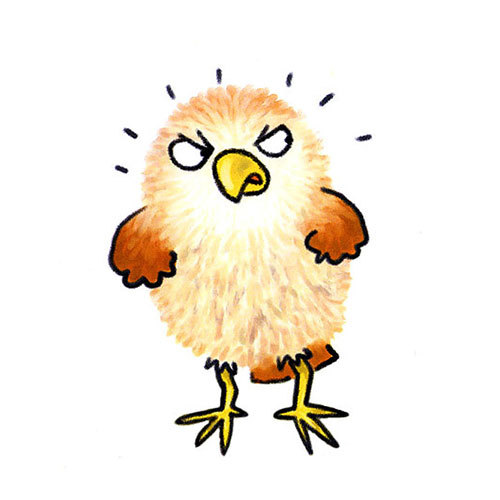
For a start, getting a new idea in front of an editor is almost impossible. I'm not talking about for me per se, as I can jump the queue to some extent by citing my track record, (in theory anyway) but for any hopeful writer or illustrator.
A lot of publishers and agents don't even bother with standard rejection letters, they just don't reply to unsuccessful submissions, as if this is a perfectly normal and acceptable way to treat people.
Well it isn't. It's rude and disrespectful. Don't give me that "Due to number of submissions" stuff.
Don't, one the one hand, ask for submissions and then react as if everyone is wasting your precious time with their crappy submissions. OK, it takes time and is tedious to send a standard rejection email? (2 minutes??) But it is an acknowledgement of somebody's effort and as such the right thing to do. imho and all that. rant rant rant. . .

The other thing I realised as I surveyed the Picture Book world from my aforementioned cave was that after a great many years of thinking up, working out, roughing out and submitting ideas, is that there is an underlying process of attrition going on. A slow wearing away of your inner strength and confidence. Success is great, you get paid to do what you love, you get feedback and affirmation and all that stuff. But there is a constant pressure there, your next idea has to be good enough to get published, or if not that idea, the next one etc etc. Somewhere, deep down it wears you away slowly. Obviously, rejection doesn't help. After a few rejections you start to lose your confidence in your ability to tell what is or isn't a good picture book idea, and if it means that you are going to be financially challenged if you don't get something accepted soonish it all gets unhelpfully stressful. Low level anxiety is not the best head space in which to be effortlessly creative that's for sure.
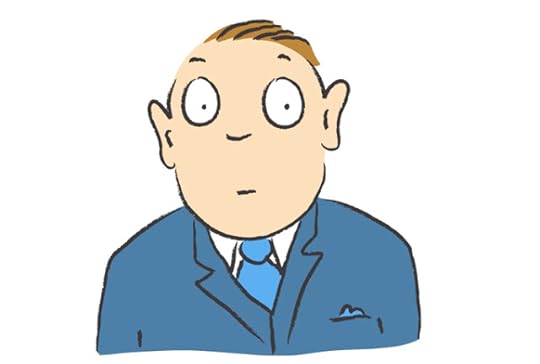
The other other thing I realised was that my style is very much out of fashion. I have, over the years smugly told myself that because my style has never been in fashion as such, it can't go out of fashion. Wrong. . .
This is all my current perception, and I realise it may be a distorted view based on partial evidence, but nevertheless I believe there is some truth in it. There is, as I mentioned in a blog post a few months ago, an obsession in current picture books with 1950's style design orientated artwork. Retro style done by artists whose parents were probably not even born then. There is some lovely work out there, but I mourn the lack of emotional connection in the work. At worst it is a pale pastiche of an empty clichéd style I'm afraid. A sort of fake nostalgia. It is very much about composition and very stylised representations of people and animals etc. Nothing approaching an individual character. As my work is all about individual character, facial expressions and emotional connection with that character, I don't fit in at all with the zeitgeist.
That's ok, I wish all illustrators all the luck in the world, I just have to accept my time is not now, thats all.

I thought the unthinkable the other week. I thought "What would it feel like not to put myself through this any more?" This was a sacreligious concept, and one that stopped my in my tracks for a while. Writing and illustrating has been my life for the best part of 35 years, I can't just 'not do it any more'!
But the overriding feeling I got was one of huge relief. I had to listen to that.
But if I stopped writing and illustrating, how would I live? Well, I get royalties, I get the max PLR every year (hah!). I am mortgage free and the kids have left home. I even have a pension that I hadn't really thought about for years, I could spark that up, after all I am imminently 59 years old, (!) I can chug along at a low but acceptable level. I have other interests, I always have had, and I can earn a small amount from those. It's not a wildly unfeasible proposition.
And besides, if I take the pressure off myself, I am free to mess around with picture book ideas from a position of wanting to rather than feeling I need to. It may be a creatively liberating experience, who knows?
Anyway, whatever I decide to do, I send best wishes to you all and the best of luck,
Jonathan x
Published on February 15, 2016 03:50



